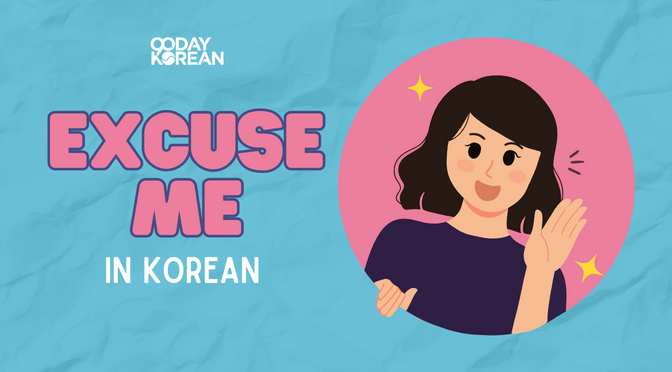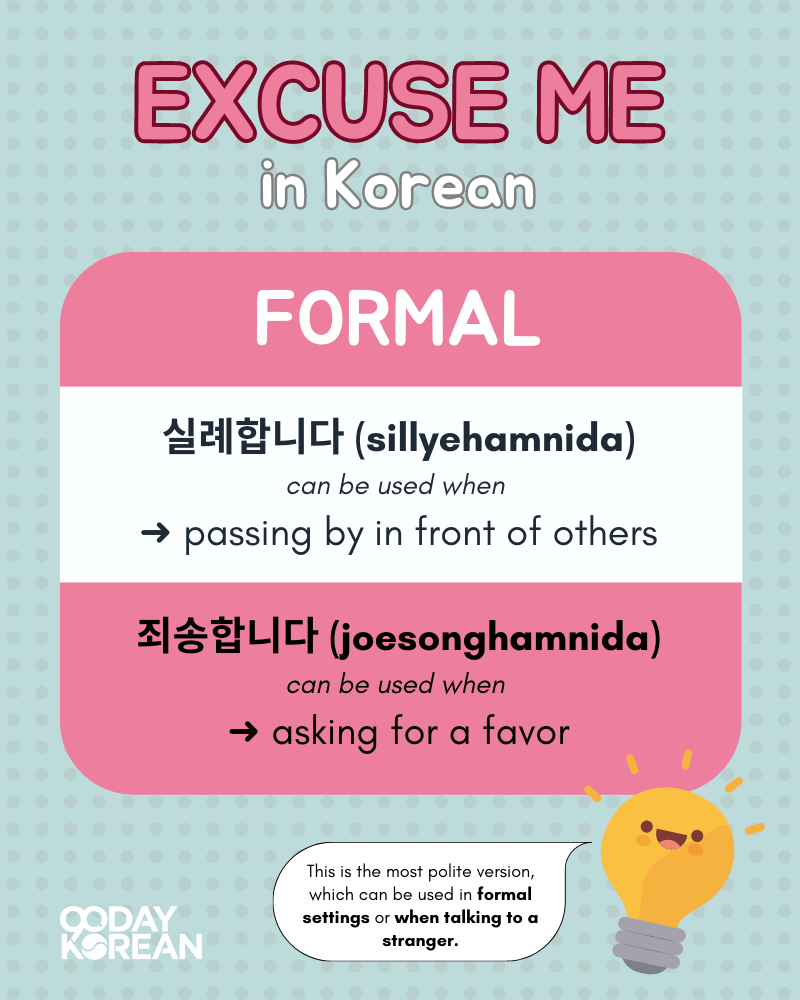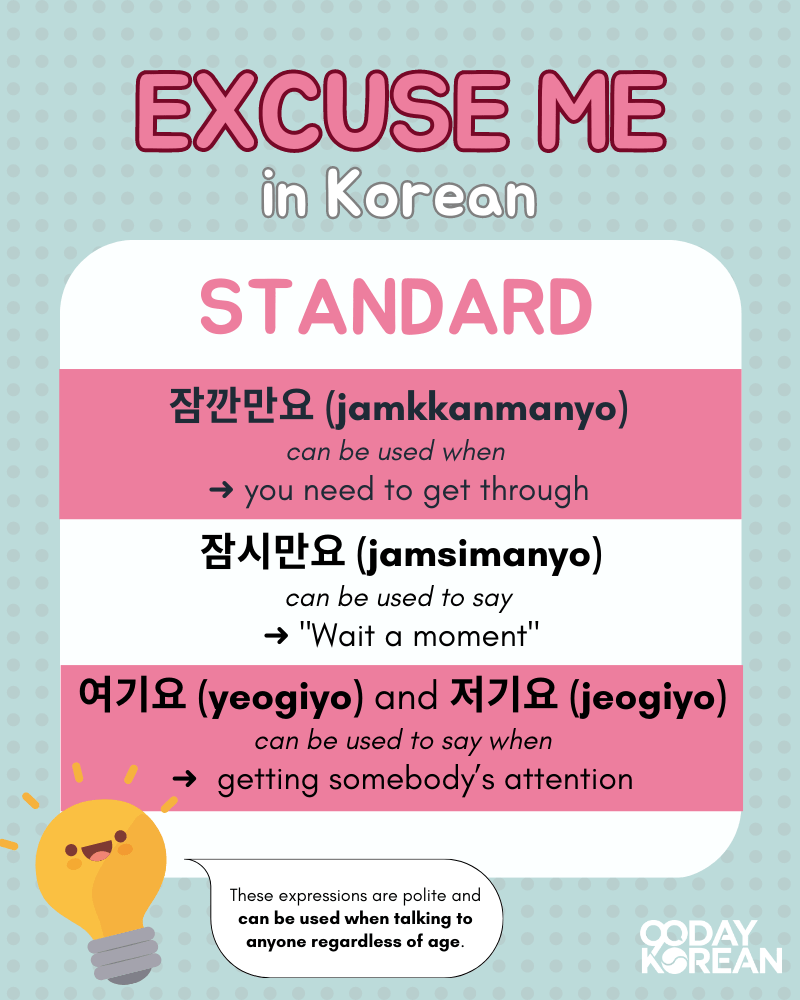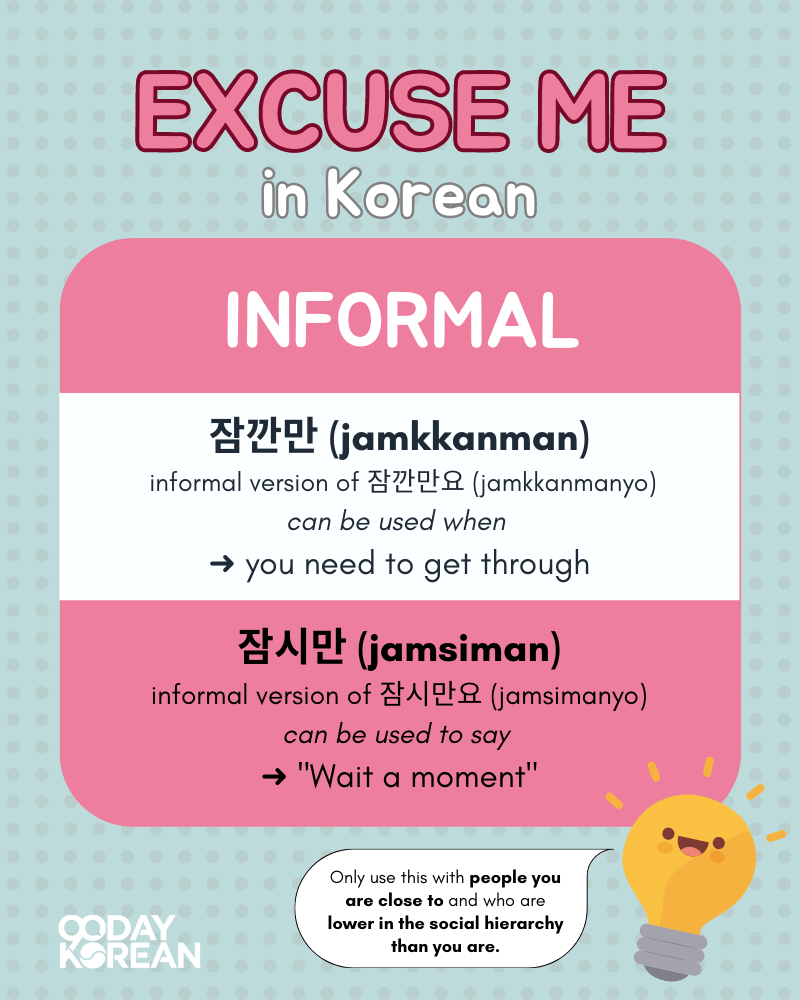Saying “excuse me” in Korean is more of an adventure than you might expect!
The phrase used depends on the situation, the speaker, and the listener. Once you consider these three factors, you will know how to say “excuse me” in Korean naturally.
There are many ways to say “excuse me” in Korean. To know which one is the best to use in any given situation, it is important that you listen and observe Korean life to get a feeling of how different words are used. Let’s get to it!
Contents
We also have a free PDF guide you can take with you on the go. Check it out below:
How Do You Say “Excuse Me” in Korean?
There are different ways to say “excuse me” in Korean, depending on who you are speaking with. Here’s a quick guide that you can refer to.
You can watch our video on How to Say “Excuse Me” in Korean before going deeper into the article:
Formal “Excuse Me” in Korean
There are many ways to express “excuse me” in Korean. One way to say it in Korean is to express it using the formal version. It’s important to learn this version so you can show respect and be polite to anyone you say this phrase.
실례합니다 (sillyehamnida)
This word is used when trying to get somebody’s attention and is very polite and formal. If in doubt, use 실례합니다 (sillyehamnida) because even if you are wrong, at least you aren’t being rude. You can use this word if you want to approach a stranger on the street, for example, if you need to ask for directions.
Example:
실례합니다, 혹시 화장실 어딘지 아세요? (sillyehamnida, hoksi hwajangsil eodinji aseyo)
Excuse me, do you happen to know where the bathroom is?
You can also use this when passing in front of others.
Example:
실례합니다. 좀 지나갈게요. (sillyehamnida. jom jinagalgeyo.)
Excuse me. I’m going to pass by.
Associations for 실례합니다 (sillyehamnida)
To remember this phrase, imagine that to approach strangers in a street (or formal setting), you need your silly ham (pig) to say excuse me for you. Your pig is wearing a suit, so you know it’s formal.
Standard “Excuse Me” in Korean
You can use two standard Korean expressions when saying “excuse me.” Both of these are polite, so it’s safe to use them for anyone, regardless of age.
잠깐만요 (jamkkanmanyo)
This Korean word means “wait a moment” but is sometimes used to mean “excuse me.” It should be used if you need somebody to move out of your way. As a cultural note, you will probably notice that people often push past others without saying anything. Saying “excuse me” is far less common in Korea than it is in other countries.
Example:
잠깐만요, 이 문제를 다시 한 번 설명해 주세요. (Jamkkanmanyo, i munjereul dasi han beon seolmyeonghae juseyo.)
Wait a moment, please explain this problem one more time.
잠시만요 (jamsimanyo)
Like 잠깐만요 (jamkkanmanyo), 잠시만요 (jamsimanyo) is also used to say “wait a moment.”
Example:
잠시만요, 제가 지금 확인해 보겠습니다. (Jamsimanyo, jega jigeum hwaginhage bogesseumnida.)
Just a moment, I’ll check right now.
Sometimes, this is also used to mean “excuse me.” For example, you might use the word if you are on a subway and need people to step aside so you can get through.
Although both 잠깐만요 (jamkkanmanyo) and 잠시만요 (jamsimanyo) are used to say “excuse me,” especially when passing through a crowd, they are not widely utilized because people frequently push past others without saying anything.
However, if you want to show good manners, then use one of these two words when pushing past somebody. If you need to choose, use 잠시만요 (jamsimanyo) as it sounds less rude when said to strangers.
Both these words are quite useful, so we recommend learning them shortly after you know basic Korean greetings.
여기요 (yeogiyo) and 저기요 (jeogiyo)
You can shout either 여기요 (yeogiyo) or 저기요 (jeogiyo) when trying to get somebody’s attention. An example of when to use this would be calling the waiter in a restaurant.
Example:
여기요, 이 자리 비어 있나요? (Yeogiyo, i jari bieo innayo?)
Excuse me, is this seat empty?
저기요, 이 책 가지고 계신 분 계세요? (Jeogiyo, i chaek gajigo gyesin bun gyeseyo?)
Excuse me, is there someone here who has this book?
To remember the common phrase 여기요 (yeogiyo), just think of the cartoon character Yogi Bear in a restaurant asking for the waiter with a “yo!“. Remember, the sillier the associations you make, the more likely you are to recall them.
Informal “Excuse Me” in Korean
The informal “excuse me” in Korean is the same as the standard versions, except without the 요 (yo) at the end. Make sure you’re using this with people you are close to and who are lower in the social hierarchy than you are.
잠깐만 (jamkkanman)
This informal version means the same as the standard version 잠깐만요 (jamkkanmanyo). It means “wait a moment” or “excuse me.” But you won’t use this for people who are older than you, someone who holds a higher position than you, or even for strangers.
You can use this version for people who you have a close relationship with, such as friends or people younger than you.
Example:
잠깐만, 다시 말해 줄래? (jamkkanman, dasi malhae jullae?)
Wait, can you say that again?
잠시만 (jamsiman)
This expression is the informal version of 잠시만요 (jamsimanyo). It also means the same as 잠시만요 (jamsimanyo).
However, this would be appropriate to use with people with who you can speak informally, such as your friends and siblings, if you normally speak informally with them.
Example:
잠시만, 전화 좀 받아 볼게. (jamsiman, jeonhwa jom bada bolge.)
Just a moment, let me answer the phone.
Use Korean titles in addressing someone
Rather than shouting out 여기요 (yeogiyo), you might hear somebody using a person’s title in order to call somebody or grab their attention.
The word you use depends on the other person’s gender and age compared to you. It might feel a bit strange at first shouting 이모 (imo | literally meaning “aunt”) across the room, but if you feel confident, give it a go.
When addressing females, guess low when judging their age so as to not cause offense. These words are useful when you need to get the attention of somebody who isn’t in a restaurant, for example, a bus driver.
Example:
아저씨, 문 열어 주세요 (ajeossi, mun yeoreo juseyo)
Bus driver, can you open the door, please?
If you want to use these kinds of words, follow the usage guide below:
| Korean | English |
|---|---|
| 이모 (imo) | older woman who you are close to |
| 누나 (nuna) | slightly older woman (used by males) |
| 언니 (eonni) | slightly older woman (used by females) |
| 아줌마 (ajumma) | older woman |
| 아저씨 (ajeossi) | older man |
| 사장님 (sajangnim) | boss / shop owner |
“Excuse me” in Korean – To Ask A Favor
In situations where you could potentially replace excuse me with “sorry,” then you can say 죄송합니다 (joesonghamnida).
Sorry can be used in situations when you need to ask for a favor (such as asking for a picture to be taken) and would most likely be translated in English as “Excuse Me” in these situations. Read our guide to How to Say ‘I’m Sorry’ in Korean for more details.
Example:
죄송합니다, 다시 한 번 말씀해 주시겠어요? (Joesonghamnida, dasi hanbeon malsseumhae jusigesseoyo?)
I’m sorry, could you please say that again?
You can also check out our Korean Phrases list of everything you need and level up your Korean skills!
There are many different ways of saying, “Excuse me.” The best way to learn how to say “excuse me” in Korean correctly is to listen and observe how Koreans use these words. Then, try to copy them.
Wrap Up
Now’s a great time to “excuse” yourself and practice this expression.
Interested in learning more about Korean? We have an awesome structured course that can help you learn Korean fast. Have a 3-minute Korean conversation in just 90 Days! Know more about it here.









Is it common to say 저기 or 여기 in a casual setting without the 요?
Yes, you can say 저기 or 여기 without 요 in a casual setting like when speaking to someone younger than you or someone you are close to.
What can you say when you want to pass by? For example on a crowded train and you want to get out. Thank you.
Hi, Jen! You can say 저기요, 좀 지나갈게요 (=Excuse me, I’ll pass). ^^